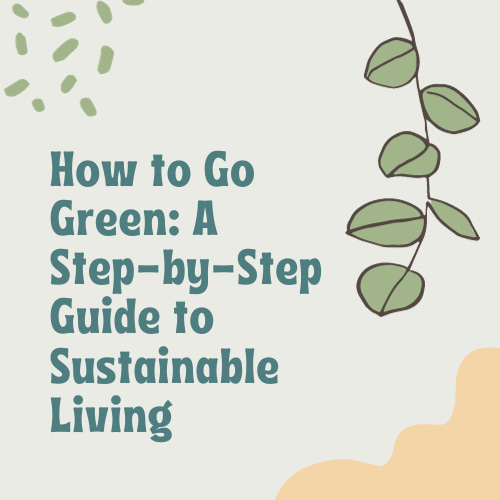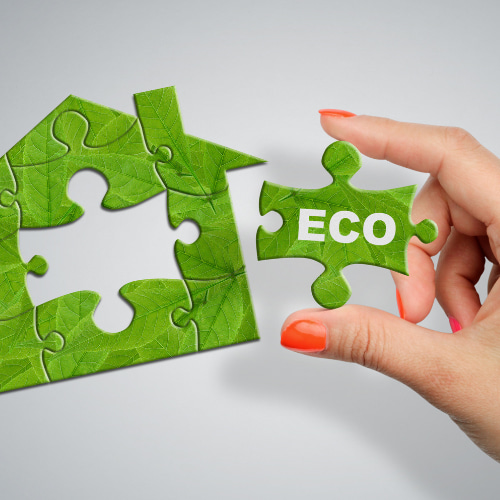How to Go Green: A Step-by-Step Guide to Sustainable Living
Discover the ultimate guide on how to go green with actionable tips and eco-friendly practices. Explore simple steps to embrace a more sustainable lifestyle and make a positive impact on the planet. Start your green journey today!
This post may contain affiliate links, I earn from qualifying purchases at no extra cost to you. Click here for my disclosure policy

Why do people go green?
Going green, or adopting a more sustainable and eco-friendly lifestyle, is essential for several compelling reasons:
- Environmental Conservation:
- Going green helps protect the environment by reducing the carbon footprint, preserving biodiversity, and mitigating the impact of human activities on ecosystems.
- Climate Change Mitigation:
- Sustainable practices contribute to the reduction of greenhouse gas emissions, playing a vital role in addressing climate change and its associated impacts.
- Resource Conservation:
- By adopting green habits, individuals contribute to the conservation of finite resources such as water, energy, and raw materials, ensuring their availability for future generations.
- Health and Well-Being:
- Green living often involves choices that promote healthier lifestyles, such as consuming organic foods, reducing exposure to harmful chemicals, and increasing physical activity.
- Economic Benefits:
- Many green practices, such as energy efficiency and waste reduction, can lead to cost savings for individuals and businesses. Investing in renewable energy sources can also stimulate economic growth.
- Preservation of Ecosystems:
- Going green supports the preservation of natural habitats and ecosystems, safeguarding the delicate balance of flora and fauna that contribute to the health of the planet.
- Reduced Pollution:
- Sustainable practices minimize pollution of air, water, and soil, leading to cleaner environments and improved overall public health.
- Water Conservation:
- Adopting water-saving habits helps address water scarcity issues and ensures the sustainable use of this essential resource. Use energy-efficient appliances like a dishwasher, washing machines that don’t fill water up for a full load, etc to decrease water use
- Sustainable Agriculture:
- Supporting sustainable farming practices promotes healthier soils, reduces the use of harmful pesticides, and encourages ethical treatment of animals.
- Air Quality Improvement:
- Choosing cleaner transportation options and reducing reliance on fossil fuels contributes to improved air quality, reducing respiratory and cardiovascular health risks.
- Waste Reduction:
- Green living emphasizes the principles of reduce, reuse, and recycle, leading to less waste in landfills and a more circular approach to resource use.
- Renewable Energy Adoption:
- Transitioning to renewable energy sources, such as solar and wind power, helps diversify the energy mix and reduces dependence on non-renewable fossil fuels.
- Global Responsibility:
- Going green is a collective responsibility to protect the planet for current and future generations, acknowledging the interconnectedness of global ecosystems.
- Preservation of Biodiversity:
- Sustainable practices contribute to the conservation of diverse plant and animal species, preventing the loss of biodiversity.
- Social Responsibility:
- Embracing green living reflects a commitment to social responsibility, recognizing the impact of individual choices on communities and societies at large.
- Inspiring Change:
- Leading by example and adopting green practices inspires others to follow suit, creating a ripple effect that contributes to broader environmental awareness and positive change.
- Resilience to Environmental Challenges:
- A sustainable lifestyle helps build resilience to environmental challenges, including natural disasters and climate-related events.
- Ethical Consumerism:
- Choosing products and services from companies with environmentally friendly and ethical practices encourages responsible business behavior.
- Long-Term Sustainability:
- Going green is an investment in the long-term sustainability of the planet, ensuring that resources are managed in a way that supports continued well-being.
- Aesthetic and Recreational Enjoyment:
- Preserving natural landscapes and green spaces enhances the aesthetic beauty of the environment and provides recreational opportunities for communities.
You’re likely already well aware of why it’s important for people to try to live more eco-friendly lives. Everyone lives on this planet, so we all have a part to play in protecting it.
If your home is designed to be eco-friendly, it’s more sustainable for the environment and your lifestyle. Sustainable habits waste less energy and resources, which can also have an impact on your wallet, giving you even more incentive to make your home more eco-friendly.

How To Go Green:
In today’s world, the importance of adopting a green lifestyle cannot be overstated. This step-by-step guide empowers you with practical tips and eco-friendly practices, making sustainable living achievable and rewarding.
In this post we’ll be digging into the following questions:
- How can we go green?
- What can we do to be more environmentally friendly?
Assessing Your Current Lifestyle
Conducting a Personal Environmental Audit
Conducting a personal environmental audit involves taking a closer look at your daily habits and their impact on the environment. It’s essentially a self-assessment to understand your ecological footprint, which includes the resources you consume and the waste you generate. Here’s how you can conduct a personal environmental audit:
- Energy Use: Examine how you use energy in your home. Consider the appliances you use, how often you leave lights on, and your heating or cooling practices.
- Water Usage: Evaluate your water consumption patterns. Look at how long you shower, if you leave taps running unnecessarily, and how often you water your plants or lawn.
- Waste Generation: Assess your waste production, including both recyclables and non-recyclables. Take note of the amount of single-use plastics, packaging, and disposables you regularly use.
- Transportation: Reflect on your commuting habits. Whether you drive, use public transportation, bike, or walk, consider the environmental impact of your chosen mode of transportation.
- Shopping Habits: Examine your shopping patterns. Are you buying products with excessive packaging? Do you opt for eco-friendly and sustainable products?
By conducting this audit, you gain insights into areas where your habits might be less environmentally friendly. It sets the foundation for positive changes and helps you prioritize adjustments for a more sustainable lifestyle.
Identifying Areas for Improvement in Daily Habits
Once you’ve completed your environmental audit, the next step is to pinpoint specific areas for improvement in your daily routines. This involves identifying habits that can be modified to reduce your environmental impact. Here are some examples:
- Reusable Water Bottle: Switching from single-use plastic bottles to a reusable water bottle is a simple yet impactful change. It reduces plastic waste and encourages a more sustainable approach to hydration.
- Compost Bin: Introducing a compost bin to your kitchen helps divert food scraps from landfills. Composting not only reduces the amount of organic waste in disposal but also creates nutrient-rich compost for your garden.
- Energy-Efficient Practices: Identify opportunities to reduce energy consumption. This could involve turning off lights when not in use, unplugging devices, and investing in energy-efficient appliances.
- Shorter Showers: If your environmental audit reveals excessive water usage during showers, consider implementing shorter showers to conserve water. This small adjustment can make a significant impact over time.
- Carpooling or Public Transportation: If your transportation habits contribute to a large carbon footprint, explore alternatives like carpooling or using public transportation. This not only reduces emissions but also promotes a more sustainable commuting culture.
By focusing on these small but impactful changes, you can contribute to a more sustainable lifestyle while minimizing your ecological footprint. It’s about cultivating awareness and making conscious choices in your daily activities.

Sustainable Living in Everyday Choices
Greening Your Home
Energy-Efficient Practices
Reduce energy consumption within your home by replacing traditional bulbs with LED or CFL bulbs and upgrading to Energy Star-rated appliances. Develop habits like turning off lights and electronics when not in use, and consider installing a programmable thermostat for optimized heating and cooling.
Waste Reduction and Recycling Tips
Implement recycling and composting practices at home by setting up separate bins for recyclables and organic waste. Use eco-friendly cleaning products like vinegar and lemon juice to minimize the use of harmful chemicals.
Eco-Friendly Product Choices
Make conscious choices by opting for reusable items, choosing products with minimal packaging, and selecting items made from sustainable materials. By incorporating these choices, you contribute to a reduction in waste and support a more sustainable production cycle.
Transportation
Explore eco-friendly commuting options by opting for public transportation, carpooling, biking, or walking. When traveling, adopt sustainable practices such as using a reusable water bottle and bringing a durable shopping bag. These choices contribute to a reduction in plastic waste and support businesses committed to environmentally responsible practices.

Mindful Consumption
Mindful consumption, a cornerstone of adopting a green lifestyle, involves conscientious choices that impact personal well-being and the environment. Starting with a keen awareness of product ingredients, opt for items with sustainable sourcing, avoiding harmful chemicals and deforestation contributors. Assess the carbon footprint, choosing locally-produced goods to minimize transportation impact. Prioritize products with minimal, eco-friendly packaging, supporting businesses committed to sustainable practices.
Embrace responsible shopping by choosing minimally packaged items, utilizing reusable bags, and avoiding harmful chemicals. Practice conscious consumerism by aligning purchases with values, supporting sustainable brands, and minimizing single-use plastics. By adopting mindful consumption, individuals contribute to a healthier planet and inspire businesses to prioritize sustainability, fostering a collective journey toward a more eco-friendly future.
Embracing Renewable Energy
Transitioning to renewable energy sources is a pivotal step towards a more sustainable lifestyle. Consider options such as solar power(Check out this guide to solar panel installation to figure out if this is an option for you.), wind energy, hydropower, and geothermal energy for your home. Embracing renewable energy not only benefits the environment but also has positive effects on your household economy.

Sustainable Eating Habits
Incorporate plant-based foods into your diet, choose locally grown, seasonal produce, and reduce food waste through composting. Cultivate your own fruits and vegetables at home to support sustainable agriculture. By making mindful choices about the food you consume, you contribute to a more sustainable and eco-friendly lifestyle.
Community Engagement
Engage with your local community to amplify the impact of sustainable practices. Join local environmental initiatives, collaborate with organizations, and promote sustainable practices such as community gardens and energy efficiency programs. Encourage and inspire others to go green by involving family members, especially kids, and leveraging social media campaigns and workshops.
Overcoming Common Challenges
Address common obstacles in adopting a green lifestyle, such as promoting shorter showers, efficient dishwashing, and reducing the amount of trash. Provide solutions and motivation by showcasing the broader impact of sustainable habits and illustrating success stories.

How To Go Green Q & A
How can I go green easily?
Going green doesn’t have to be overwhelming; there are several easy steps you can take to adopt a more sustainable lifestyle. Here are some simple and effective ways to go green:
- Reduce, Reuse, Recycle:
- Cut down on single-use items, such as plastic water bottles and disposable cutlery.
- Opt for reusable items like water bottles, shopping bags, and containers.
- Recycle paper, glass, plastic, and other materials according to your local recycling guidelines.
- Conserve Energy:
- Switch to energy-efficient LED or CFL bulbs.
- Turn off lights and electronics when not in use.
- Unplug chargers and appliances when they’re not in use to avoid “phantom” energy consumption.
- Invest in energy-efficient appliances.
- Save Water:
- Fix any leaks in faucets or pipes promptly.
- Take shorter showers and turn off the tap while brushing your teeth.
- Collect rainwater for watering plants. You can collect and store rainwater in your backyard to keep
- Consider installing water-saving devices in your home.
- Choose Sustainable Transportation:
- Use public transportation, carpool, bike, or walk whenever possible.
- Consider hybrid or electric vehicles.
- Plan and consolidate errands to reduce the number of trips.
- Shop Mindfully:
- Buy products with minimal packaging.
- Choose items made from recycled materials.
- Support local and eco-friendly brands.
- Stop using plastic bags. Bring your own reusable bags when shopping at the grocery store. (You can even make your own from a t-shirt)
- Eat Sustainably:
- Include more plant-based foods in your diet.
- Buy locally-produced and seasonal foods.
- Minimize food waste by planning meals and composting kitchen scraps.
- Reduce, Reuse, Recycle:
- Declutter responsibly by donating or recycling items instead of discarding them.
- Embrace second-hand shopping for clothes, furniture, and other items.
- Switch to Renewable Energy:
- Investigate options for using renewable energy sources in your home, such as solar panels.
- Educate Yourself:
- Stay informed about environmental issues and sustainable practices.
- Share your knowledge with friends and family to encourage collective action.
Remember, going green is about making small, sustainable changes over time. Start with one or two habits and gradually incorporate more as you become comfortable. Every effort, no matter how small, contributes to a more sustainable and eco-friendly lifestyle.
What are 20 ways to go green?
Here are 20 ways to go green and adopt a more sustainable lifestyle:
- Reduce Single-Use Plastics:
- Use reusable water bottles, shopping bags, and containers to minimize plastic waste.
- Conserve Energy at Home:
- Switch to energy-efficient light bulbs – LED or CFL bulbs.
- Turn off lights and electronics when not in use.
- Unplug chargers and appliances when they’re not in use.
- Save Water:
- Fix leaks promptly.
- Take shorter showers and turn off the tap while brushing your teeth.
- Collect rainwater for watering plants.
- Choose Sustainable Transportation:
- Use public transportation, carpool, bike, or walk.
- Consider hybrid or electric vehicles.
- Optimize Your Commute:
- Work from home when possible.
- Consolidate errands to reduce the number of trips.
- Eat Sustainably:
- Include more plant-based foods in your diet.
- Buy locally-produced and seasonal foods.
- Minimize food waste by planning meals and composting kitchen scraps.
- Shop Mindfully:
- Buy products with minimal packaging.
- Choose items made from recycled materials.
- Support local and eco-friendly brands.
- Reduce, Reuse, Recycle:
- Declutter responsibly by donating or recycling items.
- Embrace second-hand shopping for clothes, furniture, and other items.
- Conserve Water:
- Fix leaks promptly.
- Take shorter showers and turn off the tap while brushing your teeth.
- Collect rainwater for watering plants.
- Switch to Renewable Energy:
- Investigate options for using renewable energy sources in your home, such as solar panels.
- Invest in Energy-Efficient Appliances:
- Choose appliances with the Energy Star label to reduce energy consumption.
- Practice Mindful Consumption:
- Be aware of the environmental impact of the products you purchase.
- Choose items with sustainable and eco-friendly certifications.
- Plant Trees and Maintain Green Spaces:
- Participate in local tree planting initiatives.
- Contribute to the maintenance of community gardens and green spaces.
- Reduce Meat Consumption:
- Cut down on meat consumption and explore plant-based alternatives.
- Compost Organic Waste:
- Set up a compost bin for kitchen scraps, reducing the amount of organic waste in landfills.
- Educate Yourself and Others:
- Stay informed about environmental issues and sustainable practices.
- Share your knowledge with friends and family to encourage collective action.
- Support Renewable Energy Policies:
- Advocate for and support policies that promote the use of renewable energy sources.
- Use Eco-Friendly Cleaning Products:
- Contribute to Local Environmental Initiatives:
- Join or support local environmental organizations and initiatives.
- Reduce Water and Energy Usage in the Garden:
- Water your garden in the early morning or late evening to reduce evaporation.
- Choose drought-resistant plants and implement water-efficient irrigation systems.
Remember, adopting a sustainable lifestyle is about making gradual changes that align with your values and circumstances. Start with a few of these suggestions and incorporate more as you feel comfortable. Every small effort contributes to a greener and more sustainable future.
How do you encourage people to go green?
Encouraging people to go green involves inspiring a shift in mindset and behavior towards more sustainable and eco-friendly practices. Here are some effective strategies to encourage individuals to embrace a green lifestyle:
- Highlight Benefits:
- Emphasize the personal benefits of going green, such as cost savings on utility bills, improved health, and a sense of contributing to a healthier planet.
- Provide Education:
- Offer information on the environmental impact of certain habits and choices. Knowledge empowers individuals to make informed decisions.
- Demonstrate Easy Steps:
- Showcase simple and achievable steps to go green. Starting with small changes makes the transition more manageable and increases the likelihood of long-term adoption.
- Share Success Stories:
- Share success stories of individuals or communities who have successfully adopted green practices. Real-life examples can inspire and provide tangible evidence of the positive impact.
- Create Community:
- Foster a sense of community by bringing like-minded people together. Community support can provide encouragement and a shared commitment to sustainability.
- Leverage Social Media:
- Utilize social media platforms to share tips, success stories, and information on sustainable living. Engaging content can reach a broad audience and create awareness.
- Offer Incentives:
- Provide incentives for adopting green practices, such as discounts on eco-friendly products, community rewards, or recognition for sustainable achievements.
- Host Workshops and Events:
- Organize workshops, webinars, or local events to educate people on sustainable living. Practical demonstrations and hands-on experiences can be powerful motivators.
- Collaborate with Local Businesses:
- Partner with local businesses to promote and offer green products and services. This collaboration can create a more accessible and supportive environment for sustainable choices.
- Make It Convenient:
- Simplify the adoption of green practices by making eco-friendly options readily available and convenient. For example, set up recycling bins in accessible locations.
- Appeal to Personal Values:
- Connect green living with personal values and goals. Whether it’s promoting health, well-being, or a desire for a cleaner environment, framing the message in alignment with individual values can be compelling.
- Engage Schools and Educational Institutions:
- Collaborate with schools and universities to integrate sustainability into educational curricula. Educating the younger generation can have a lasting impact on future behaviors.
- Celebrate Green Achievements:
- Acknowledge and celebrate individual and community achievements in adopting green practices. Recognition can reinforce positive behavior and inspire others.
- Provide Resources:
- Offer resources such as guides, toolkits, and online platforms that make it easy for individuals to access information and support for their green journey.
- Create Challenges or Competitions:
- Develop friendly challenges or competitions that encourage participants to adopt and share their green initiatives. This can foster a sense of camaraderie and friendly competition.
- Offer Guidance for Overcoming Challenges:
- Address common challenges and provide practical solutions. Knowing how to overcome obstacles can make the process less daunting.
- Encourage Peer Influence:
- Harness the power of peer influence by encouraging friends and family members to adopt green practices together. Social support can be a strong motivator.
- Promote Local Initiatives:
- Highlight and support local initiatives that promote sustainability, such as farmers’ markets, tree-planting events, or environmental clean-ups.
- Connect with Nature:
- Encourage spending time in nature. Building a connection with the environment can foster a deeper appreciation for sustainability.
- Celebrate Earth Events:
- Participate in and celebrate events like Earth Day. These occasions provide an opportunity to amplify the message of environmental stewardship.
Remember, the key is to make sustainability accessible, relatable, and appealing to individuals’ values and lifestyles. Tailoring the message to resonate with diverse audiences can contribute to a broader and more lasting adoption of green practices.

How To Go Green Conclusion
As we conclude this comprehensive guide on embracing a sustainable lifestyle, let’s recap the key steps that pave the way to a greener, healthier future. From conducting a personal environmental audit to incorporating renewable energy and sustainable eating habits, each action contributes to a collective effort towards environmental stewardship. The journey to sustainability involves mindful consumption, responsible choices, and active community engagement.
The time for change is now. Start your green journey today by implementing the practical tips and eco-friendly practices shared in this guide. Small, intentional choices in your daily life can have a significant impact on the environment. Whether it’s reducing water usage, embracing renewable energy sources, or making mindful decisions while shopping, each action contributes to a more sustainable and eco-friendly lifestyle.
By taking the first step towards sustainability, you join a global movement dedicated to preserving our planet for future generations. It’s not about perfection but progress—a continuous journey of learning and adapting. Your commitment to a greener lifestyle is a powerful force for positive change. So, let’s embark on this journey together, making mindful choices that echo a commitment to a sustainable and eco-friendly future. Start today, and let your actions be the catalyst for a more environmentally conscious and harmonious world.
Further Reading








